
46 minute read
BOSCH DINION IP 3000I TURRET IR
● Product Review Bosch
Bosch Dinion IP 3000i Turret IR is a compact day/night PoE turret camera and the NTV-3503-F02L version we are testing has a 2.3mm F1.6 aperture fixed lenses and strong resolution of 3072 x 1728 pixels for a total of sensor area of 5.3MP.
Advertisement
INION IP 3000i – our test camera is the
D NTV-3503-F02L - is a compact turret with a modest current draw offering solid all round performance, that’s best in good to low-ish light. The camera has serious resolution and a monster 120-degree angle of view, thanks to the squat 2.3mm focal length of its moderately fast fixed lens. The camera makes the most of these attributes to deliver good situational awareness, with court admissible faces to 10-15 metres and excellent recognition and observation qualities further still.
Thanks to its robust cast alloy construction, the camera is rated IK08 against vandals striking at 5 joules impact – the equivalent of the impact of a 1.7 kg mass dropped from 300mm above a surface. There’s also IP42 rating for protection against tools and small wires greater than 1mm and from water sprays at less than 15 degrees from vertical.
Before we go further, let’s run through some specifications. This version of the 3000i turret features Intelligent Dynamic Noise Reduction with separate temporal and spatial adjustments, intelligent defog, video content analysis with rule-based alarms and tracking, line crossing, enter/leave field, follow route, loitering, idle/ removed object, people counting, crowd density estimation and 3D tracking. Additional functions include privacy masking via 8 independent areas, fully programmable display stamping of name, logo and time, as well as alarm messages and pixel counter of selectable areas.
The camera’s internal RAM can store up to 5 seconds of pre-alarm recording, while a microSDHC/microSDXC SD card slot supports 1TB cards for more complex automatic network replenishment (ANR) edge recording requirements. The camera has a built-in microphone to allow operators to listen in on the monitored area. Audio detection can be used to generate an alarm if needed. Full duplex audio streaming options includes standard G.711 with an 8 kHz sampling rate through to AAC-LC running at 80 kbps and a 16 kHz sampling rate. Signal-tonoise ratio is less than 50dB.
Adjustable picture settings include contrast, saturation, brightness, white balance (2500 to 10000K), 4 automatic modes (basic, standard, sodium lamp, dominant colour), manual and hold mode, the video functions include ALC, there’s automatic electronic shutter (AES); fixed shutter from (1/30 to 1/15000) selectable and default. You can select day/night auto (adjustable switch points), colour, monochrome, video functions – enhance, there’s selectable sharpness enhancement, backlight compensation and contrast enhancement.
There’s also fully configurable H.265 multistreaming. According to Bosch, the camera is designed on the most efficient and powerful H.264 and H.265/HEVC encoding platform and
BY JOHN ADAMS
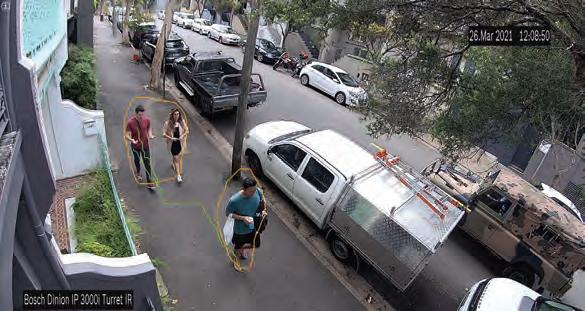
Faces are easy.

Depth of field decent, too.

Afternoon softness.

● Product Review Bosch

Colour performance.

There’s some tone mapping.

With high IR. can deliver quality images stream at low bitrates. The 3000i supports ONVIF Profile S, ONVIF Profile G and ONVIF Profile T, as well as GB/T 28181.
Data security is a Bosch priority, and the company says measures have been put in place to ensure the highest level of security for device access and data transport. The 3-level password protection with security recommendations allows users to customize device access. Web browser access can be protected using HTTPS and firmware updates can also be protected with authenticated secure uploads. Bosch says the on-board Trusted Platform Module (TPM) and Public Key Infrastructure (PKI) support guarantee superior protection from malicious attacks. The 802.1x network authentication with EAP/TLS, supports TLS 1.2 with updated cipher suites including AES 256 encryption.
This camera is 122 x 129mm in size, weighs 576g and runs on POE IEEE 802.3af/802.3 at Type 1, Class 3 on a voltage of 12V DC with a 30 per cent variation either way. Maximum draw is 10.5W, with a standard draw of around 3.5W.
The camera head features 3-axis adjustment through pan/tilt and rotation (pan is to 350 degrees, while tilt is from 0-78 degrees), while the operating temperature range is -20 to 50C. Assisting installations are mirror image function, image rotation options from 0-270 degrees, and camera LED disable. A wide range of configuration options is available for alarm activations signalling camera tampering and a built-in algorithm for detecting movement in the video stream can also be used to signal tamper alarms.
Bosch quotes DORI figures for the 5MP turret with 2.3mm lens – detection at 37 metres (25px/m), observation at 15 metres (63px/m) recognition at 7 metres at (125px/m) and identification at 4 metres (250 px/m). These are stringent numbers – I think the camera pushes court admissible identity out past 10 metres, though this margin shrinks as light levels drop.
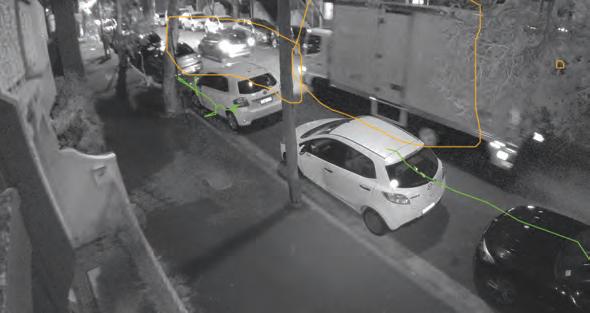
TEST DRIVING 3000I
Bosch Dinion IP 3000i Turret camera surprised right from the start with its sure-footed performance in more than slightly horrible variable lighting conditions that moved between deep shadow and glaring backlight. Initial settings are close to default for the test – sharpening is elevated, and backlight compensation is on, while intelligent dynamic noise reduction and dynamic sharpness and noise filtering are both activated. With these settings, the camera shows off excellent all-round performance during daylight hours in good light.
This should come as no surprise – we were very impressed with the Bosch 3000i Bullet recently and there’s some technical crossover in the family. The turret form factor tends to make you think performance will be a compromise. Instead what
you get with the Bosch Dinion IP 3000i Turret is a very wide angle of view arm-in-arm with excellent resolution delivering solid performance in good and failing light.
There’s a distance – it’s around 15-20 metres – where subjects move out of the lens’ optimum focal plane, as well as moving into the area of pixel spread - where softness becomes apparent. But within that distance through a monster 120-degree angle of view, Bosch’s Dinion IP 3000i Turret delivers strong sharpness, contrast and colour, and low blur. It’s a combination that makes this camera a real powerhouse for mid-range applications where you need to see everything all the time.
Our test starts in the morning and it’s immediately apparent the 3000i turret does solid work against backlight. I have court admissible faces on my side of the street, though I never feel I have them over on the bright side of the road – about 12-plus metres from the lens. Performance with snaring plates is pretty good, too, considering the angle of view and the pixel spread it engenders. During the middle period of the day, as the light swings wildly from glaring 70,000 lux to gloomy 14,000, I remain sure that with a bit of fiddling I could dredge plates out of the middle of my scene.
Considering the enormity of the angle of view – it really is huge, stretching from the line of terraces on the left all the way around to a point past 90 degrees over the road – performance is excellent. Colour tones are natural, perhaps a little muted as light levels fall and WDR performance is solid. I note a little veiling flare from the turret face, which is mounted on the Magic Arm at right angles to the ground, but that’s is not a typical application for a turret.
Something I do like for a street application like this, is that I am getting faces and similarly high levels of detail all the way in from 10 metres through the full angle of view. I grab a couple of shots to highlight this capacity – it’s worth having. The view is not only wide, it’s taller than you’d see with a longer focal length – that brings in more detail still. You don’t think about it until you’re noticing people’s shoes and socks within 8m – even within 4m – usually this close to the lens where detail is highest, those details would have moved out of your horizontal or vertical angles of view.
The image stays solid all afternoon – it’s moving into autumn here in Sydney, so the sun is a bit lower in the northern sky. This and the partial, thick cloud cover, start to have an impact later in the day. I begin getting some softness in the image. I notice it first in vehicles and then in faces. Because of the variable light – by this time I have an intense bright patch to the right of the scene, with shade through the rest of the angle of view – I spend a bit of time trying to wrap camera settings around the application. After turning backlight on and off a few times, I feel I am getting more amplification noise without it and put up with a slightly darker scene.
Fast moving plates are gone by 430pm but I still have court admissible faces at 6.20pm when the light has evened out and I hang onto them till around 7pm, when light fades faster. You’d expect a comparatively compact camera sensor with 5.3MP resolution and a very wide angle of view to tend to be softer in low light thanks to pixel spread and smaller photo sites, and that’s how it proves to be. Something I do notice is that the camera refuses to shunt over into monochrome in sub 4 lux on the street. By this time there’s fore and aft tone mapping of fast-moving cars, and tone mapping is evident around pedestrians, too. It’s not about frame rate – it’s the way the camera manages areas of activity while ensuring slender bitrates.
Static details are high at 8pm in full dark. There’s slight yellow colour casting at the bottom of the street. In this light level, identifying pedestrians and vehicle plates is not possible – there’s blur and amplification noise – but the static parts of the scene are tidy – sharper close to the lens. Light balance across the frame is good, too, as is colour rendition. There are no dark holes in this scene at all, and I find I’m able to get vehicle makes, models, colours, modifications without any trouble and depth of field is good – I have detection of people and vehicles very deep into the scene.
I have to push the camera into night mode to get
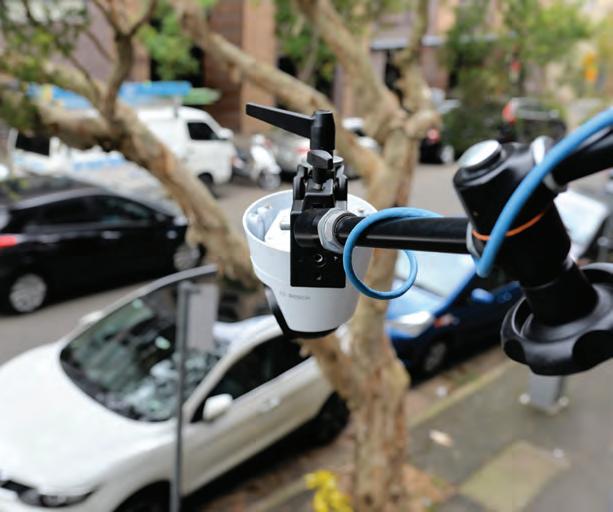
l Product Review Bosch
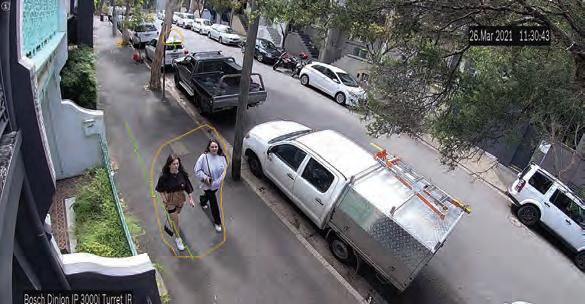
WDR performance is a strength.

Here’s WDR at the very edge.
a look at IR performance in monochrome. The IR array offers 15 metres of reach – that’s conservative – I can see IR flare from plates up to 25 metres away. Something else I notice immediately is that the IR array’s spread is relatively narrow compared with the large optical angle of view – it’s also relatively strong. I’m happier with IR performance inside 8 metres with the IR array backed right off, especially if there’s a touch of ambient light from adjacent flood lights or from carried smart devices.
Assisted night performance does a good job with pedestrians outside of face recognition – I have gait, attire, head shape, hair tone and style, footwear design, carried items. With IR activated I have recognition of a person by those who knew them or from photographs. The camera’s observation capabilities are also enhanced with IR on – I can see people walking on the road at 20 metres and again, these images would allow recognition by friends or family.
I spend a lot of time playing with camera settings in support of IR, particularly shutter speed, and find the best street performance with movement at close range is using a shutter speed of around 100th of a second and keeping IR on its lower settings. For general detection or observation of complex scenes, colour at default was preferable. THE CAMERAS OBSERVATION CAPABILITIES ARE ALSO ENHANCED WITH IR ON – I CAN SEE PEOPLE WALKING ON THE ROAD AT 20 METRES.
CONCLUSIONS
Bosch Dinion IP 3000i Turret is a solid camera, well built and with plenty of smart functions, including onboard analytics and clever event reporting. The camera’s resolution and enormous angle of view – wide and tall – means that within 15 metres of the lens in good light it gives levels of detail you’d never get with longer lens. During the day and within 10 metres, court admissible face recognition is standard fare and moving plates can be recognised fully or partly using digital zoom. WDR performance is a particular strength.
In lower light levels the camera doesn’t give moving plates or faces, but general monitoring characteristics for detection or observation are good. The camera does best with the IR array eased off and responds well to the presence of ambient light. If you have a very wide view and your depth of field is from 10-15 metres, this Bosch Dinion 3000i turret is well worth a look. n
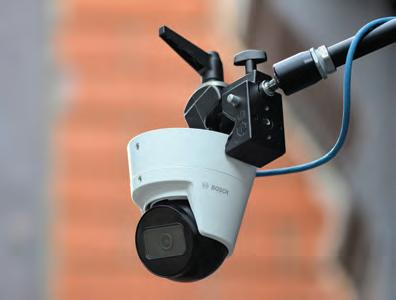
FEATURES OF THE BOSCH DINION IP 3000I TURRET INCLUDE:
l 5MP resolutions, 2.3mm lens, big 120-degree angle of view l Robust IK08 build with IP42 protection against water sprays l Built-in Essential Video Analytics to trigger relevant alerts and quickly retrieve data l Fully configurable H.265 multi-streaming l Wide Dynamic Range (120 dB) for challenging bright and dark scenes l Built-in IR illuminator with 15 m (49 ft) viewing distance.
Your Monitoring Specialists
1300 130 515
www.bensecurity.com.au ● Regulars Monitoring
Sequential Sensors
Is it possible to design a wired alarm installation that reduces false alarms? The most obvious way is by rigging up the system so that 2 separate sensors in nearby areas can be activated sequentially over a short period of time. The sensors need not both be PIRs - a glassbreak and a dual technology sensor could be combined, or a PIR and a dual technology sensor.
HE principles we’re talking
T about here conform to the UK’s DD243 standard which is designed specifically to eliminate false alarms. The sequential combinations of sensors allowed under DD243 include: ● 2 detectors of different technologies i.e. break glass & movement ● 2 detectors, same technology with minimal or non-overlapping areas ● 2 dual technology movement detectors or 1 passive infra-red and 1 dual technology movement detector; coverage may overlap but detectors must be located some distance apart ● 1 alarm and 1 tamper ● 1 communications line fault and 1 alarm or tamper ● faults on 2 separate communications paths.
The sequential combinations not allowed under DD243 include: ● 2 single technology movement detectors overlapping ● 1 double knock combination i.e. 2 activations from 1 detector ● 2 vibration or break glass detectors overlapping ● 2 foil on glass on same door/window ● 2 switches on same door ● 2 atmospheric detectors ● 2 audio detectors or video motion detectors.
The audible and visual verification techniques are designed into systems and managed by the user’s monitoring station using microphones or cameras incorporated into sensing devices at the monitored premises.
Controlled verification to a standard is a great idea. As all monitoring station operators know, opening times and close of business generate a flood of false alarms from alarm systems that are designed or configured in ways that make it possible for users to trip over their own feet on exit.
Systems that require users to negotiate half the building after activating the alarm are not a great idea. Users will find innumerable ways to get side-tracked on their way out, whether it’s picking up one last phone call near the exit door or making a quick bathroom stop that extends longer than they’d planned.
And none of this considers the fact that lengthy delays on activation tend to encourage users to adopt a more relaxed attitude to getting out of the building – as well as making users more likely to return for some forgotten item. In order to get around these sorts of problems, you can set up alarm systems to conform to DD243 standards using the following methods: 1) Key operated shunt lock on final exit door 2) Push button outside the premises 3) Door contact on the final exit door 4) Electronic token 5) In conjunction with the alarm receiving centre 6) For systems installed to the new European Standards, EN 50131, other means.

You might also install disarm methods that include: 1) System disarm by unlocking the initial entry door
Your Monitoring Specialists
1300 130 515
www.bensecurity.com.au

2) Unlocking the entry door disables all confirmation then system un-set internally (as present) 3) Opening the initial entry door disables all confirmation (not acceptable to most insurers) 4) System is unset using an electronic token for example a proximity fob, smart key or infra-red/radio fob 5) Un-setting carried out in conjunction with the Alarm Receiving Centre.
Along with these changes there are rules that can make it tenable for patrols not to attend false alarms without compromising the inherent security of alarmed premises. If a remote keypad is to set and unset your alarm, entering by the designated entry/ exit door must disable all confirmation in the building. This means that a burglar who enters by that door will not cause more than one signal to be transmitted to the Alarm receiving centre (ARC) if straying off the designated entry route.
To overcome the above, the system will need to have a different means of setting and un-setting. The options are: 1) By means of unlocking the entry door with the use of a combined lock and keyswitch. 2)In conjunction with the ARC 3)Portable ancillary control equipment (radio key fobs, proximity tokens, etc.) 4)Access control equipment.
As part of this process, resetting of the alarm system after an activation can now be done by the user, unless patrols are called, in which case the ARC can perform the reset remotely, or the alarm company must be called, whichever is appropriate. And finally, after an activation of the alarm from a single detector, the system will re-arm within a set time. If a door sensor caused the alarm, and the door consequently remains open, or any other detection device is indicating an alarm state when the system tries to re-arm, that door/ device will be omitted from the alarm, therefore leaving a gap in the security of the building. n
● Q&A Video Analytics
AI – AN OPERATIONAL PERSPECTIVE
In this Q&A, John Adams speaks with Ken Francis of Eagle Eye Networks about operational perspectives of artificial intelligence, touching on key functionalities, planning, integration and the importance of the API economy to analytics solutions of the future.
JA: How important is it when planning for artificial intelligence to ensure you maintain an operational perspective and don’t get too swayed by the ‘cool’ factor? KF. It’s extremely important for end users to maintain an operational perspective and share this with their system integrator and video surveillance vendor. This collaboration will enable the integrator and vendor to provide the expertise and appropriate technology to meet the end user’s specific operational needs. Then, looking purposely at ‘cool’ and how it can be applied to today’s and tomorrow’s challenges, ensures the right balance of operational success and future-proofing a system to grow and last.
JA: There’s an understandable tendency for consultants to cover off AI in specifications in a general way – do you think it would be more helpful if required AI functionality was outlined specifically from the start? KF: Absolutely. When there are too many cooks in the kitchen, the dish may end up overly spicy, or otherwise negatively affected. Similarly, without clearly specifying the desired AI from the beginning, you could end up with a kludgy fusion that, in many cases, is difficult to use. The specification of AI at the front end enables all tech companies in the stack to effectively contribute around a consistent AI selection and help the end user achieve a fully integrated system that meets its specific needs.
JA: What’s the low hanging fruit when it comes to AI – what AI functionalities offer security teams the most for the least, in your opinion? KF: The most effective AI is functionality that extends over the greatest group of users. The security analytics of line crossing, advanced motion, and people counting, are proven and widely applicable today. The next generation of widely applicable analytics will come from recognition of people, things, and events.
This next wave of AI is becoming more commonplace, due to high demand from end users and greater supply from companies now offering it. Specifically, the need for recognition-oriented AI is growing in critical infrastructure, citywide surveillance, and large campuses (both corporate or university), primarily to reduce manpower requirements and accelerate incident resolution.
JA: Which are the AI areas with the greatest potential in the future – what functionalities should installers and integrators definitely be covering off? KF: Our recent study showing the most often-used analytics in cloud video surveillance clearly indicates that physical security remains the priority, but we’re starting to see analytics and AI for more than just security. People are rapidly adopting it to help run the business. Customer service and support appear to be the leading areas of interest, but anywhere a business can glean information to improve operational efficiency and effectiveness, reduce maintenance costs, and lower risk are all areas to cover off. breadth of lateral application – it very quickly stops being about security when skipping between functions – for instance, AI that allows CCTV cameras to establish recent contacts, check security patrol schedules, identify problem gamblers, etc. How important is it that these sorts of lateral applications are considered in advance by security integrators and their technology partners, and how can security integrators best promote lateral applications that diverge so widely from the security function? KF: It’s absolutely critical that real problem-solving solutions be designed in advance of installation. The value-added security integrator is key to the design process. He/she brings the know-how to the table to help create a long-term strategy for connecting and managing the various security components, in the most cost-effective way, to achieve optimal system functionality.
JA: A quirk of AI is that it is making its appearance at multiple points in the product stack – with optical and thermal CCTV cameras and their viewers, in touchless disarm alarm panels, in access control reader modules of multiple types, within NVRs, within apps and within management solutions. Is it possible to integrate all these disparate versions of AI, or do end users need to decide well in advance how they want AI to apply to their overall solutions in order to avoid creating networks of high touch points? KF: This is a great question. Early selection of AI in the video system enables the video system tech company to provide an application programming interface (API) for the select AI, enabling all tech stack participants to share in the AI-generated events. The sharing of a common API is the best method for long-term stability and support. The API should be thought of as the central component within an economy.
JA: How important is it that AI solutions can integrate with security

and related subsystems at one level, and with management systems at another level? KF: AI has moved from being about technology to becoming a critical part of business strategy. Securely connecting mission-critical business applications brings the ability for a business to collect and distil data to applicable business intelligence. The businesses that lead the way are those that can bring distributed and fragmented systems and subsystems together to cross-reference and quickly find information across a multitude of mediums that can lead to better decision making, services, products, etc. In video surveillance, this is happening most successfully in open, true cloud platforms that have the ability to bring partners and technology together to make the world safer and businesses more efficient and effective.
JA: In your experience, how eager are end users to apply AI and what sorts of AI functions are of most interest to them? KF: Over the past few years we’ve been impressed with the way large businesses and enterprise customers have quickly understood the value of AI and its application to security and business challenges. The small- to medium-sized business owner might have understood the potential of AI, but for many it seemed out of reach because of the infrastructure costs and challenges of legacy security systems. That is changing.
The ubiquity and scalability of our true cloud platform democratizes and makes AI more affordable and accessible for virtually every type and size of business. The conversation has changed from ‘can we do that?’ to ‘what is possible?’ Initially the discussion is typically centred around improving security, but as more people understand what’s possible, it becomes about business insight and optimisation. JA: If there was one vital attitude to bring to the AI-empowered future, what would it be? KF: Open architecture/open platforms are terms commonly used across tech industries. API Economy is the next generation of this terminology, and a well-known movement in tech. The API Economy will enable organisations to find innovative new ways to extend and complement their services and create value for customers. In the big scheme of things, the API Economy will help the video surveillance industry make businesses smarter and the world a safer place. n
● Case Study Terracotta Warrior Museum
GUARDING THE GUARDIANS
At China’s most-visited cultural heritage sites, like the famous Terracotta Warrior Museum and Summer Palace, tourists from across the world come face-toface with history. Behind the scenes, intrusion detectors from Bosch protect the irreplaceable statues, weapons, and ornaments against theft and damage.
F OR operators of museums, galleries, and historic sites, showcasing public exhibits is a double-edged sword. On one hand, they want to provide visitors with a rich experience of history, unobstructed by barriers and obvious limitations. But on the other hand, they also need to ensure the safety and integrity of the rich cultural treasures on display. Achieving this balance is especially important at UNESCO World Heritage Sites like Emperor Qin Shi Huang’s Mausoleum in Xi’an, China. Discovered in 1974, the site is home to a 2,000-year-old army of clay statues, the Terracotta Warriors, guarding the tomb of China’s first emperor.
When the outdated intrusion detection system at the Terracotta Warriors Museum required upgrading, several key security challenges emerged. First, the sheer volume of thousands of


visitors per day called for fast and fail-safe alarms when exhibits are at risk. Aside from the constant risk of criminals looking to steal exhibits, the biggest threat comes from tourists dropping their phones or cameras into the pits, then overstepping the threshold and potentially causing damage. Second, the installed solution needed to function under extreme conditions, as the pits holding the several thousand clay warrior statues collect large amounts of dust that can deter detectors.
And third, the security system was to remain discrete without interfering with the experience of the life-sized warrior and horse figures. Keeping these factors in mind, Bosch experts deployed a combination of several hundred intrusion detectors across the 16,300-square-metre museum area. For rapid detection of security breaches, the team installed wall-mounted detectors in the

pits alongside the clay warriors, supplemented by ceiling-mounted detectors above visitor walkways and open areas.
Intrusion panels G-Series detectors in the pits use PIR and microwave noise adaptive processing technology. Integrated on G Series control panels, the detectors rely on microwave Doppler RADAR and infrared technologies – enhanced by first step processing (FSP) algorithms – to detect changes in infrared energy and radar signals when a person oversteps a pre-defined security boundary inside the museum and along the perimeter.
Eliminating false alarms from dust and other environmental interference, the detectors in the pits use passive infrared (PIR) sensors and microwave Doppler RADAR. As a special feature, ceiling mounted motion detectors deliver accurate intrusion detection although mounted high on the THE COOPERATION WITH BOSCH IS AN EXCELLENT SHOWCASE OF MODERN HIGH-TECH PROTECTION OF HISTORIC BUILDINGS. BOSCH INTRUSION ALARM SYSTEMS HELP TO UPGRADE THE SECURITY LEVEL OF THESE UNIQUE HISTORIC SITES.
Terracotta Army Museum’s vaulted, 4.8-meter-tall ceilings; exceeding the limits of standard ceiling detectors by more than 2 meters.
In case of an actual intrusion attempt, the Bosch G Series control panels trigger an alarm to the museum’s control room within only 2 seconds. Aside from the exact location of the triggered detector, the security team also receives surveillance camera images from the scene in realtime, made possible by integration with a thirdparty video security platform. This situational intelligence allows personnel to respond in a rapid and efficient manner.
Outside the public view, the integrated security system also answers another key requirement for museum operators: As a large part of exhibit pieces are stored away at any time – but still need protection from theft – Bosch detectors safeguard the storage facilities that can therefore remain unmanned, saving significant personnel cost. The result is a win-win situation: Museum operators enjoy the peace of mind that comes from knowing that historic exhibits are safe from theft, damage, and intrusion. And visitors receive an up-closeand-personal experience of ancient artefacts without any fences and barriers limiting the experience.
“The cooperation with Bosch is an excellent showcase of modern high-tech protection of historic buildings,” said Ren Xuxin, project manager of Xi’an Terracotta Warriors and Horses Pit Security Upgrade Project. “Bosch intrusion alarm systems help to upgrade the security level of these unique historic sites.” n
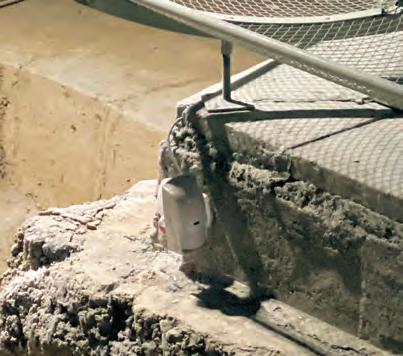
● Regulars Products
Editor’s choice What’s new in the industry.
INVIXIUM INTEGRATES WITH GALLAGHER FOR CONTACTLESS BIOMETRIC TEMPERATURE & MASK DETECTION
● GALLAGHER Security and touchless biometric solutions maker, Invixium, have announced a next-level integration between Gallagher Command Centre and Invixium’s IXM WEB software to develop an integrated, user-friendly solution to address the global market’s immediate, health-oriented needs. IXM TITAN with Enhancement Kit is Invixium’s flagship biometric reader and hallmark of its COVID-19 solution, which delivers simultaneous face recognition and elevated body temperature detection* at the medial canthus (tear duct). Through this integrated solution, TITAN will now communicate health events such as temperature screening and mask detection to Gallagher’s security management platform, Command Centre. Alarm notification events – such as elevated body temperature or the absence of a face mask – will be captured in Command Centre’s Alarm Viewer. Distributor: Gallagher Contact: +61 2 9412 4477

NEW SMARTAIR I-MAX ESCUTCHEON FROM ASSA ABLOY
● New SMARTair i-max Escutcheon from ASSA ABLOY ensures only authorised users pass through doors, via a range of credentials including virtual keys stored on a smartphone. Fast, wire-free installation makes it easy to implement or extend a SMARTair access control system in any building. This new wireless escutcheon with an inbuilt RFID reader and Bluetooth compatibility handles the punishment of high-traffic, frequent-use doors. It meets standard EN 1906 Category of use: Grade 4 for robustness — the highest level, recommended for doors which are subject to frequent violent use. The new escutcheon is battery-powered and works with all standard proximity credential technologies, including MIFARE, DESFire, and iCLASS. An optional integrated PINpad provides the opportunity to add another layer of security with multi-factor authentication. One can specify individual doors to open with PIN verification or credential verification — or to require both. The i-max escutcheon comes in a variety of contemporary finishes and handle options, with up to 16 different combinations. Distributor: ASSA ABLOY Contact: +61 3 8574 3888 NIROVISION VISUAL CONTACT TRACING REPORT
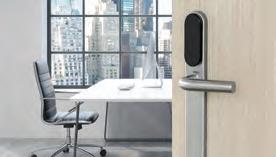
● VISUAL Contact Tracing is a Nirovision feature that lets workplaces generate a detailed report with just a few clicks. Using Nirovision apps, customers select a time range to see who an individual was seen with, what cameras they were seen on, and which other people were seen within a similar window of time. Operationally, you open the Nirovision web app and choose an identity from your database, then click on it to access their full profile. Next, select the Contact Tracing report button. Choose your target date and time frame, and run the report. The report is made of 3 lists: a list of cameras that person was seen on (sorted from most seen to last seen), a list of close contacts (those seen together on camera) and a list of people seen within a similar window of time. Click any camera or close contact in the list to access its event carousel. Click on any event for playback to and learn more (such as finding out if the event triggered an alert). Distributor: Nirovision Contact: 1800 339 027

QX INFINITY SERIES – WIDE ANGLE OUTDOOR DETECTOR
● OPTEX QX Infinity series is a family of compact outdoor PIR and dual-technology sensors providing 12m detection area, up to 120-degrees in width, with mounting heights of up to 2.7m. New Quad technology features a pyro element that has been redefined by OPTEX and supports a greater performance with a double layered detection in a compact design. The QXI series features improved Super Multi-Dimensional Analysis (SMDA) logic and Double Conductive Shielding for more reliable sensing capabilities and greater tolerance against light and RFI. It allows for greater immunity against pets and can also be installed as a low mount PIR detector to create a ‘pet alley’ and further reduce the likelihood of nuisance alarms. Installing the sensor has been made simple with an easy to open/close front cover. Other features include an automatic walk test mode, which automatically starts when the cover is closed and returns to normal mode after 3 minutes. Distributor: Hills Contact: 1800 685 487

HIKVISION DS-2XS6A25GO SOLAR BULLET CAMERA
l HIKVISION has released the new EXIR 4G solar bullet featuring 2MP resolution, 120dB WDR technology and a battery pack that allows the unit to operate for 7 rainy or cloudy days if the 20Ah lithium battery is fully charged by the 40W photovoltaic panel. There’s support battery management, battery display, battery high-low temperature protection, charge-discharge protection, low-battery sleep protection and remote wakeup LTE-TDD/LTEFDD/WCDMA/GSM 4G wireless network transmission, support Micro SIM card Camera: Water and dust resistant (IP67). The camera has a ½.8-inch progressive scan CMOS sensor with minimum scene illumination of 0.004 in colour at F1.4 with AGC on, or 0.002 Lux @ (F1.4, AGC ON), 0 Lux with IR on in monochrome. The bullet camera is available with the option of a fixed 2.8, 4, or 8mm fixed lens, giving 41 to 107-degree angles of view. Contact: Hikvision Distributors
ARITECH ANNOUNCES LAUNCH OF NEW CHALLENGER 4-DOOR ACCESS CONTROLLER
l ARITECH says the launch of the new 4-door Network Access Controller (TS1066-4) will provide customers with enhanced security solutions, strengthened on-premise protection and intrusion detection. The TS1066-4 strengthens the Challenger family of control panels by providing a new 4-door variant of the Network Access Controller. Utilising the same advanced technology found in the Network Access Controller, this 4-door model provides a costeffective access control solution for Tecom systems without compromising on features and functionality. Key Features: • On-board Ethernet and USB connectivity for connection directly into supported software • Smaller form factor than existing intelligent controllers • 8 inputs and 4 relay outputs on board • Utilises Dual Wiegand Interface (TS1061) for additional relays and inputs • Up to 4 doors per controller • Dual RS-485 busses individually configurable Distributor: Hills Contact: 1800 685 487 EOS AUSTRALIA OFFERING NEW WISENET AI NVRS

l Eos says Hanwha’s new Wisenet AI NVRs are now available and offer “superb quality images of up to 8K with precise and efficient monitoring through integration with AI cameras”. “They give users an amazing capacity to digitally zoom into large coverage areas without loss of detail,” said Andrew Cho of Eos Australia. “Users can also mouse over the video for a preview, making video and event search from multiple channels easier than ever. A new bookmark management function allows for easy retrieval and protection of video clips during an investigation. “Artificial intelligence is integrated with Wisenet P series AI cameras, the new NVRs are able to read AI metadata generated by the edge device from deep learning algorithms, enabling operators to quickly search for objects (person, face, vehicle and license plate) and attributes associated with them. Support for dynamic events allows the system to receive alarm event triggers based on current licensefree analytics as well as new analytics released in the future without requiring a firmware upgrade.” Distributor: EOS Australia Pty Ltd Contact: +61 2 9749 5888

PELCO OCCUPANCY COUNTING SOLUTION FOR VIDEOXPERT
l PELCO Occupancy Counting Solution allows you to automate the counting of people entering and exiting your facility within VideoXpert by leveraging the AI-powered Pelco Advanced Analytics Suite embedded in Sarix Enhanced 3 and Spectra Enhanced 7 cameras. The solution utilizes the existing People Counting Analytics feature in the Advanced Analytics Suite to provide a real-time occupancy count against user-defined occupancy limits. Plugin features include: • Dashboards to display occupancy counts in real-time • Ability to set different occupancy limits for each area being monitored • Alerts in VideoXpert when you reach or exceed occupancy limits • Real-time counters to display on web-enabled devices in lobbies and other areas to notify employees and visitors if they can enter or if they must wait • Reports on historical occupancy data for insights into high traffic areas and peak occupancy times. Distributor: BGWT Contact: +61 2 9674 4255

● Regulars Products
Editor’s choice What’s new in the industry.
LILIN RELEASES MINI PTZ PZD6422EX3
● LILIN’s new mini PZD6422EX3 mini PTZ dome can be controlled with a PTZ keyboard (when used with compatible NVR), through a web browser, Navigator software, LILINHome app or via a home automation system. LILIN’s range of PTZ cameras includes both non-IR and IR optionswith IR distances reaching up to 200 metres, and features including configurable pre-set positions, programmable tours and auto-tracking (available on selected models). The Mini PTZ PZD6422EX3 is 1080P HD IP66 rated dome camera featuring 3x optical zoom capability and the ability to capture highlights and shadows simultaneously, eliminating pixilation and smear. It also has an auto tracking function, is 360-degree controllable from major home systems and can easily integrate into any video control system via the free SDK. All LILIN PTZ cameras can be controlled through the free LILINViewer and LILINHome apps. Distributor: Merit Li-Lin Contact: +61 2 9646 4878
HANWHA ADDS EXTREME WDR TO MULTISENSOR CAMERAS
● HANWHA Techwin has expanded and updated its lineup of multisensor cameras featuring its Wisenet 7 chipset with Hanwha Techwin’s proprietary extreme wide dynamic range (WDR), technology which utilizes advanced local contrast enhancement and scene analysis technology. This enables the cameras to capture images from scenes containing a challenging mix of bright and dark areas, according to the company. Wisenet 7’s enhanced noise reduction technology is said to minimize motion blur and image artifacts while increasing object sharpness and definition. Hanwha says Wisenet 7 offers the highest level of cybersecurity possible by embedding unique certificates and encryption keys into every camera during manufacturing. The new multisensor cameras are fully NDAA-compliant and UL CAP certified and consume only a single license in a VSM. They also include a suite of built-in video analytics such as motion and directional detection, enter/exit, line crossing and tampering detection. All cameras include H.265 and WiseStream II compression technology and a suite of built-in Wisenet 7 analytics. Distributor: Hanwha Distributors HONEYWELL ACCESS CONTROL & INTRUSION VIA MAXPRO CLOUD AVAILABLE NOW FROM CSM
● HONEYWELL has expanded the capabilities of its MAXPRO Cloud portfolio with the launch of MAXPRO Intrusion, a new cloud integrated intrusion and access platform that delivers a unique single and multisite experience and is available locally from CSM. MAXPRO Intrusion control panel delivers a fully integrated intrusion and access control solution, which using MAXPRO Cloud technology can seamlessly integrate with video. It also provides cabling flexibility, simplified wiring and an easy configuration experience. According to CSM’s Yossi Harel, installers and integrators can purchase the latest MAXPRO Intrusion from CSM. “Consolidated Security Merchants is authorised distributor for the Integrated MAXPRO Cloud Solutions portfolio,” Harel said. “In cooperation with Honeywell, CSM will provide specialised training and high-level back-up support, to deliver a single and multisite experience with the MAXPRO all-in-one solution.” Distributor: Consolidated Security Merchants Contact: 1300663904
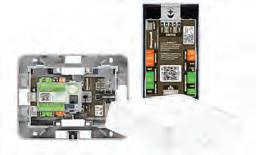
INNER RANGE INTEGRATES MITSUBISHI ELEVATORS WITH INTEGRITI
● INNER Range has released a new integration which allows the Inner Range Integriti platform to communicate directly with Mitsubishi Elevators. The bidirectional communication makes it possible for facilities with Mitsubishi Elevators to significantly increase the security while enhancing convenience. Some features included are free or secure floors, card badging, floor feedback and home floor calling. The integration operates over an IP network directly from the Integriti hardware to the Mitsubishi elevator controllers which provides major benefits such as not having to install additional cabling for the integration as well as providing robust and reliable communication as there are no servers or software sitting in the middle. The ability to easily manage, through Integriti, which floors are open to the public can instantly increase security in the building as both visitors and tenants are restricted from entering any unauthorised floors. In the case that a floor needs to be temporarily opened or closed to the public, this can be easily managed by the Integriti operator on an ad-hoc basis. Distributor: Inner Range Contact: +61 3 9780 4300

NEW AVIGILON H5A DUAL HEAD CAMERA RELEASED
l AVIGILON’S new H5A Dual Head Camera is a low-profile dual sensor indoor camera that brings enhanced security for hard to secure indoor areas, such as hallways, stairwells, and corner intersections, or any application that requires the coverage of 2 cameras installed in close proximity. Built with small spaces in mind, the indoor H5A Dual Head allows end-users to gain the security coverage of 2 cameras (2 x 3MP or 2 x 5MP) with 1 installation. Features include increased area coverage, new analytics, including support for people counting, mask detection and expanded object classifications and greater accuracy for faster responses in crowded scenes. There’s native ONVIF Profile S, T and G1 compliance allows easy integration with existing ONVIF infrastructures, and FIPS 140-2 compliance with FIPS-compliant cryptography enabled on cameras. There’s a 1/2.7-inch progressive scan CMOS, sensor with 5184 x 1944-pixel maximum resolution, up to 120dB of WDR protection, 3.35-7.0 mm remote varifocal lens with F/1.93 aperture, high power 850nm IR LEDs, and minimum Illumination of 0.1 lux . Distributor: Avigilon - Central Security Distribution Contact: 1300 319 499
NEW MILESTONE HUSKY VIDEO SURVEILLANCE APPLIANCE
l MILESTONE’S new Husky video surveillance appliance brings together Intel processing power and Milestone XProtect video management software in a range of 6 video management appliances. With its reliability, ease of use and optimal XProtect integration, the new Husky series enables partners and customers to achieve much more with their Milestone XProtect video management solution, powered by Dell Technologies OEM Solutions. Partners and customers will also get extensive service and support with a single point of contact for both hardware and software, along with the possibility to access onsite support through a global support network. “The new Husky series represents a significant evolution of Milestone’s hardware offerings to the market, enabling our partners to be geared for the future,” said Milestone’s Bjørn Skou Eilertsen. “This new portfolio brings together ease of use, performance, reliability, and optimal integration with XProtect and importantly, a comprehensive service offering and the flexibility that Dell Technologies will bring. Distributor: Hills Contact: 1800 685 487 FLIR LAUNCHES QUASAR PREMIUM MINIDOME AND QUASAR PREMIUM BULLET
l DESIGNED for use in demanding indoor and outdoor environments, the new FLIR Quasar Premium Mini-dome and Quasar Premium bullet deliver forensic image quality, tight integration, and advanced cybersecurity features required for critical infrastructure sites, remote facilities, or large areas requiring close monitoring, according to FLIR. The FLIR Quasar Premium Mini-dome is available with 5MP HD or 4K Ultra-HD resolutions, while the FLIR Quasar Premium bullet series is available with 4MP Quad HD and 4K Ultra-HD resolutions, with a variety of lens options for extended range performance for perimeter security. Both cameras have an SD-card for onedge recording and redundancy, while also meeting the H.265 video compression standard to minimise network bandwidth and storage space. The FLIR Quasar Premium Mini-dome series is IP66 rated for dust and waterproof protection and can be ceiling- or wall-mounted in minutes. In no-light conditions, the unit can also provide up to 40 metres of visibility via on-board nearinfrared illumination. Distributor: Sektor Contact: +61 2 9947 1555
PAXTON RELEASES EXTERNALLY-RATED SMART WIRELESS DOOR HANDLE
l PAXTON has announced the launch of the latest addition to its line of wireless access control solutions, the PaxLock Pro – Mortise. The smart lockset is designed for quick and easy installation to conveniently secure external facing doors. Available in black or white fascia with an Eclipse or Galaxy handle, the PaxLock Pro – Mortise is discrete and has a UL 10C fire rating, and is UL 294 rated for reliability of construction, performance and operation. The PaxLock Pro line can be installed on a network or standalone as part of a Paxton10 or Net2 system. The smart lockset goes into sleep mode when not in use to preserve battery life and allows users to monitor events and battery status online, with alerts via email and SMS. “When compared to a hard-wired solution, wireless door handles are a quick and cost-effective way to secure a door in a wide variety of building types,” said Samantha Cronin, Paxton product specialist. Distributor: Security Distributors Australia Contact: 1300 882 101
● Regulars
Help desk Our panel of experts answers your questions.

Q: We have issues with a wireless alarm system that had been working perfectly but is now losing contact with devices and giving us trouble notifications – what does SEN think could be going on? A: Sudden problems in RF alarm systems that have already been successfully commissioned are often the result of changes in the environment. Look for things recently brought into the area like metal framed pictures, metallic insulation or wallpaper, metal shelving, air conditioning, cabling and cars parked under the main roof. If you can’t discover any obvious environmental change, try moving the transmitter – shifting it a few centimetres may be all that’s required. You can turn the unit upside down taking up the same space as before yet moving the antenna a significant distance. Another option is to insert a non-metallic spacer behind the transmitter. Try swapping sensors in system around and see if there’s any improvement in reporting. A last-ditch solution is to move the receiver, but this should be a final resort. You might be able to get away with moving the receiver just a metre or 2 allowing you to keep the same power and comms links but there’s a chance you’ll have to move the receiver to another location. The introduction of noise, or passive shielding into an environment can impact on a wireless systems reliability, as well as its range. In some cases, the replacement of a sensor with a longrange device might resolve issues. In external applications, it may be possible to reimagine the system layout in a way that improves performance without compromising detection coverage.
Q: When thinking about deterrent factor on any site would you agree effective and well-planned external lighting systems are among the most important and least considered aspects of the overall security plan? A: We’d agree. Lighting’s multipurpose function means it can be used as an economical form of security. But it’s important that when initially installed, lighting system plans consider security as part of their function. Every site requires some degree of external lighting. In its simplest form, this lighting may only illuminate the main entry and exit point, and the car park of a building. Lighting should not only work to allow safe passage to and from a building after dark. It should also be designed to allow passers-by, police and security patrols to view each potential exit and entry point, including doors and windows. Lighting should allow a complete patrol circuit of a site without leaving areas of darkness in which intruders might hide. CCTV systems should also be considered here. When the lighting system is designed, illumination should be positioned to allow quality video images without dark holes or blooming in a scene. You’ll be plagued by blooming when poorly placed security lights blind a surveillance camera. Another important function of light is its use as an aggressive barrier that confronts and blinds potential intruders. Part of the strength of aggressive lighting is the feeling of being under surveillance it engenders in humans. No one likes being confronted with strong light that can’t be seen through. When used by onsite security patrols, strong light denies potential intruders the ability to view details of a site while at the same time, it allows patrol teams a clear view of approaches and dead ground around a facility. Obviously, lighting systems can’t call the police, hinder a determined intruder or make an arrest. Light can only be effective if installed as part of a complete security system. But should lighting be installed properly in combination with effective fencing, CCTV and electronic detection systems, it offers economy, low maintenance, and capable support of protection systems over many years.

There are 5 security lighting techniques which together make up the effective security lighting system. First, there’s perimeter lighting, which entails illuminating a fence line, wall, boundary or approaches with lamps facing outwards to increase the blinding effect on intruders. Next is checkpoint lighting, which allows vehicles or pedestrians to be checked in full light. It can also be designed to allow security officers in a guard post to see out, while remaining hidden to the intruder. The 3rd security lighting technique is defensive area lighting, which illuminates open spaces around buildings with lamps positioned on towers or placed high on building structures. Technique number 4 is defensive building floodlighting and involves floodlighting buildings so intruders can be seen clearly or in silhouette. The 5th lighting technique is topping up – single luminaries positioned in dark spots, like alleyways or dark entrances.
Q: Is a nitrogen-filled camera more reliable over the long term than a standard PTZ or bullet camera? A: Yes, definitely, and particularly with PTZs with motors, gears and belts. One of the advantages of pressurised nitrogen is that it excludes air from the housing and that means it excludes moisture, dust and airborne solvents and chemicals, too. No air means no condensation. Nitrogen is inert thanks to its simple molecular structure – it only has 2 atoms – this simplicity means it doesn’t break down as part of chemical chain reactions. What this means is that there’s no rust and no corrosion possible in an atmosphere of nitrogen – it’s also environmentally friendly – Earth’s atmosphere is about 80 per cent nitrogen. While nitrogen-filled cameras are robust, you need to ensure that seals are maintained – a stainless V-band with latching helps with pressure sealing. A nitrogen-filled camera should incorporate a pressure sensor that reports low nitrogen levels and mechanically, there needs to be a pressure relief valve and a purging valve incorporated into the camera housing. Q: SEN has written recently about geophone solutions being buried as an optimum solution. Given anything trenched is very expensive, would you say geophones can be applied on fences? A: Geophones can be mounted in perimeter fences where they’ll detect anything that causes vibration of the fence including climbing, lifting, ramming and cutting. But applied this way geophones should not be used as the sole line of defence and depending on the security needs of the facility would need to be supplemented by CCTV and a response team or another perimeter detection technology. Fence mounted geophones are noticeable to the professional intruder and can be circumvented, so they shouldn’t be used in high security applications. It’s also recommended that they not be used on common walls in shared offices or in retail outlets where the knocking of pipes or structural elements of the building will lead to false alarms. It’s also important not to use geophones anywhere near fence mounted gates whose openings and closings will flex the sensor. Avoid loose and poorly installed fences and trees located near fences. The best use of geophones is to have them trenched and buried where they provide high security protection with low false alarm rates.

Q: Do magnetic control keys still function and have value in access control systems – are they the same as magnetic slugs? A: Magnetic keys aren’t the same as magnetic slugs. With magnetic keys, rare earth magnets are permanently embedded in a coded pattern into a shaped blank made of a very tough nylon material. The readers use Hall effect devices to read the bit pattern (position of the magnets) in the key. Magnetic keys are an Australian design used by both Mil and DKS since 1972 and 1974, respectively. Comparatively, magnetic slugs or metal pieces are embedded or layered in a card and are read by magnetic sensing devices. Also known as a shim card these are generally limited to single code standalone applications. The reader required no power, and the output was a microswitch. These were very primitive, and it would be most unlikely that there are many still in service. Corkey was one brand sold in Australia in the late 70s*. There are magnetic key readers still in operation, though they are becoming quite rare now, and in certain applications they remain functional. The monitoring and reporting functions of legacy systems like these fall very far behind the latest solutions. n
* Thanks to Roger Pearce for these technical descriptions.

AMPLIFY YOUR MESSAGE sen
PRINT l DIGITAL l EVENTS
Security Electronics & Networks Magazine securityelectronicsandnetworks.com Weekly Enewsletter Weekly AAA Enewsletter securityandgovernmentexpo.com.au sectechroadshow.com.au





